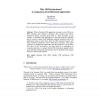JAIR
2012
12 years 7 months ago
2012
To achieve scalability of query answering, the developers of Semantic Web applications are often forced to use incomplete OWL 2 reasoners, which fail to derive all answers for at ...
DLOG
2011
13 years 8 months ago
2011
A combination of open and closed-world reasoning (usually called local closed world reasoning) is a desirable capability of knowledge representation formalisms for Semantic Web app...
SEMWEB
2010
Springer
13 years 11 months ago
2010
Springer
The modalities of search and browse dominate current thinking about interaction with the Web. Given the Web's origins as a global hypertext system, it is understandable that t...
SEMWEB
2010
Springer
14 years 2 months ago
2010
Springer
Abstract. This paper describes the theoretical background and the implementation of dbrec, a music recommendation system built on top of DBpedia, offering recommendations for more ...
SEMWEB
2010
Springer
14 years 2 months ago
2010
Springer
RDF(S) and OWL 2 currently support only static ontologies. In practice, however, the truth of statements often changes with time, and Semantic Web applications often need to repres...
IA
2006
14 years 4 months ago
2006
Automated reasoning is becoming an essential issue in many Web systems and applications, especially in emerging Semantic Web applications. This article first discusses reasons for...
GI
2008
Springer
14 years 5 months ago
2008
Springer
In order to be adopted within corporate environments, Semantic Web applications must provide tangible short-/medium-term gains. Although corporate Semantic Web offers enterprises n...
WOA
2004
14 years 6 months ago
2004
Abstract-- In this article we present a visual development environment for writing DyLOG programs, explaining the motivations to this work and the main design choices. We will also...
ESWS
2008
Springer
14 years 6 months ago
2008
Springer
When a Semantic Web application encounters a new URI in an RDF statement, how should it determine what resource that URI is intended to denote, and learn more about it? Since asser...
ESWS
2008
Springer
14 years 6 months ago
2008
Springer
To support the reuse and combination of ontologies in Semantic Web applications, it is often necessary to obtain smaller ontologies from existing larger ontologies. In particular, ...

